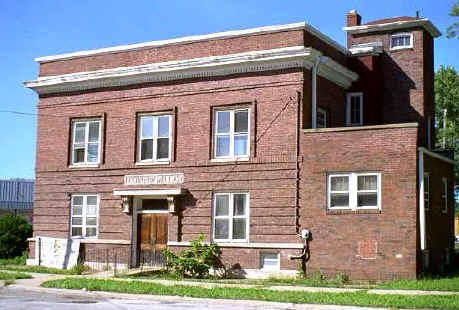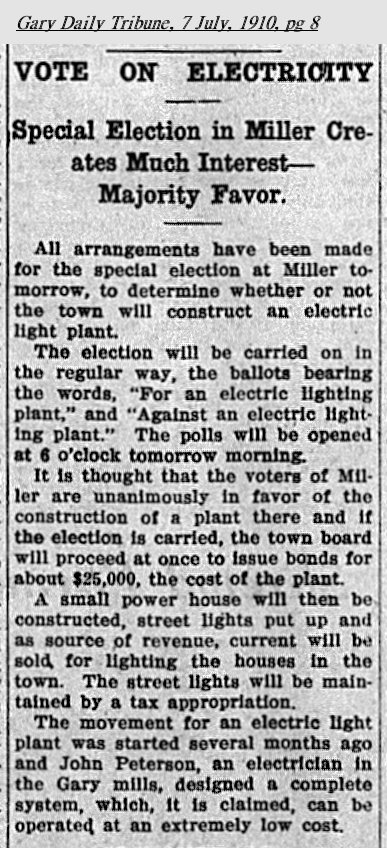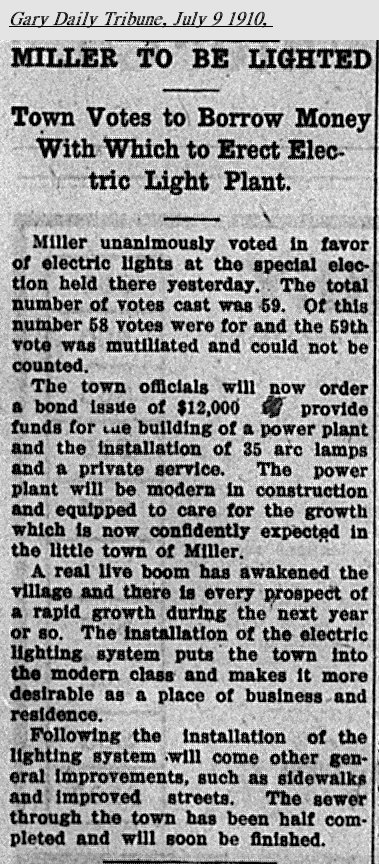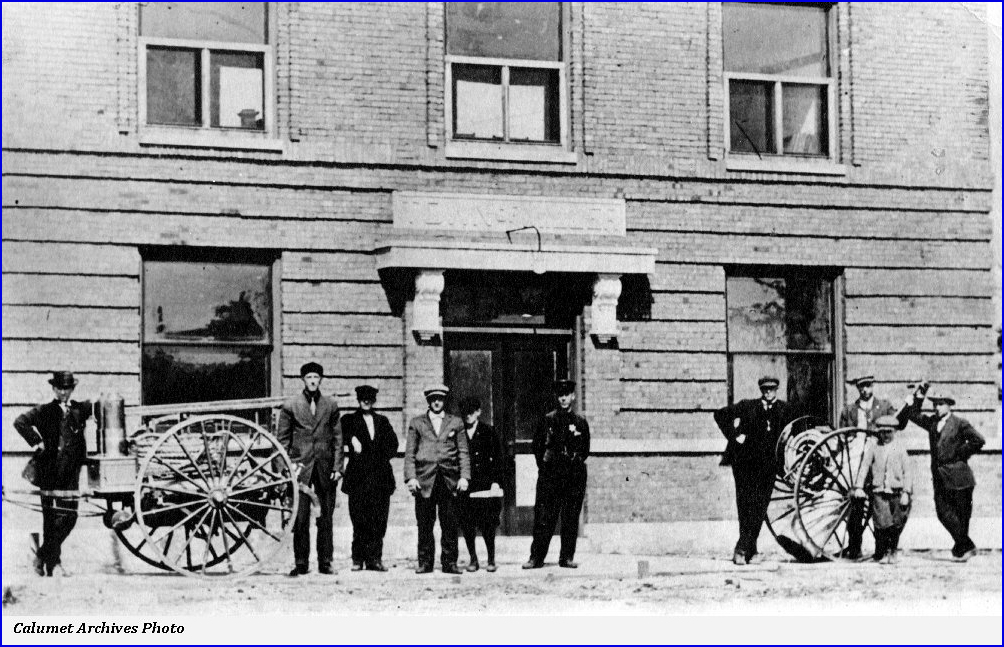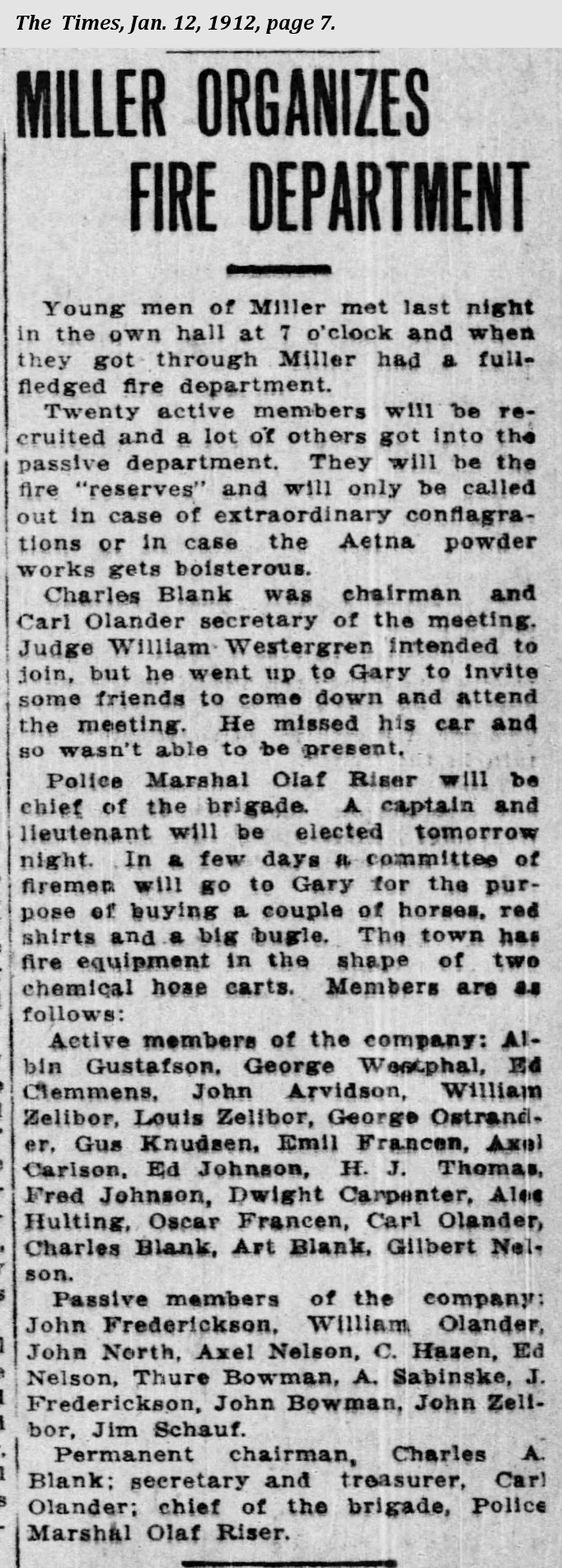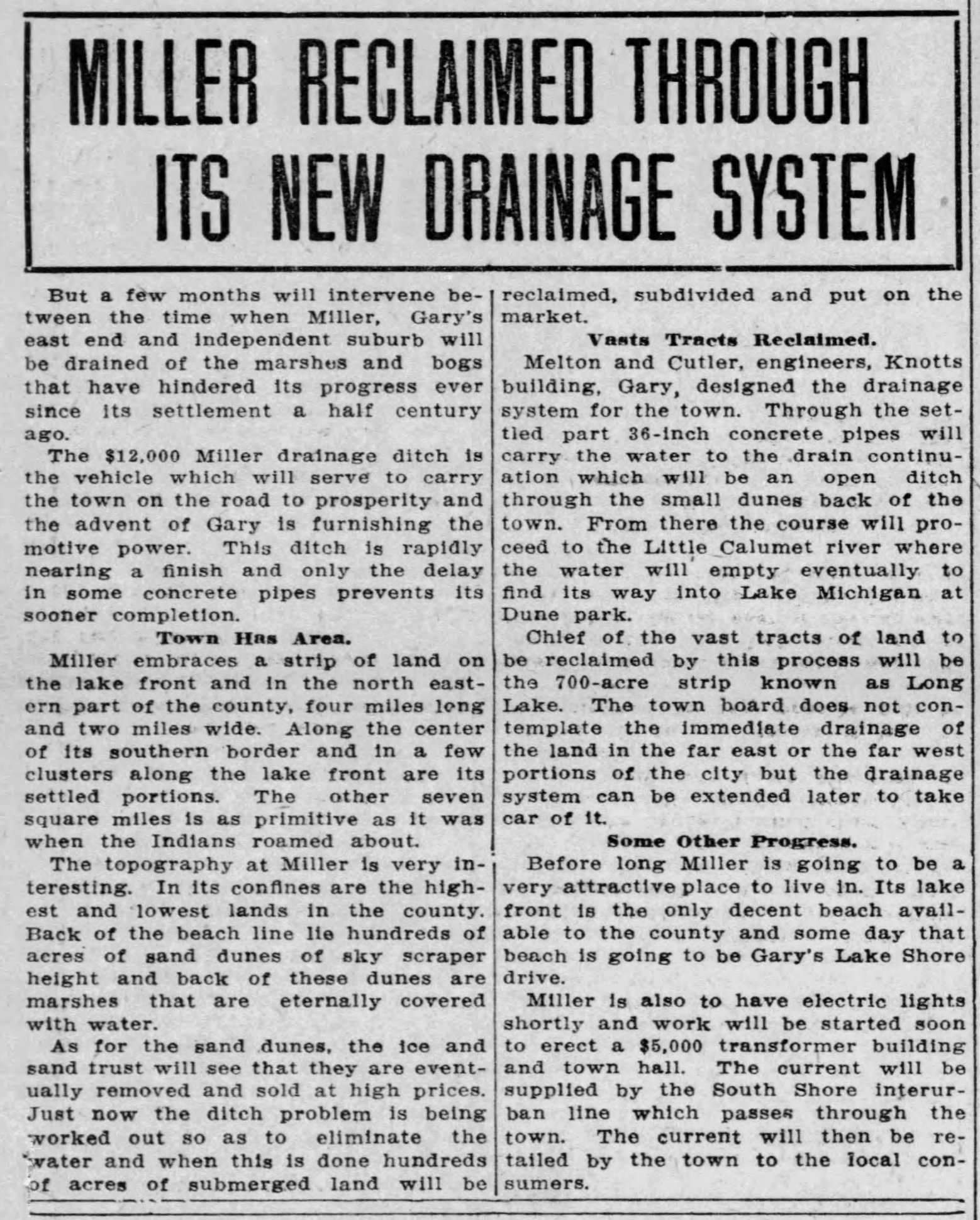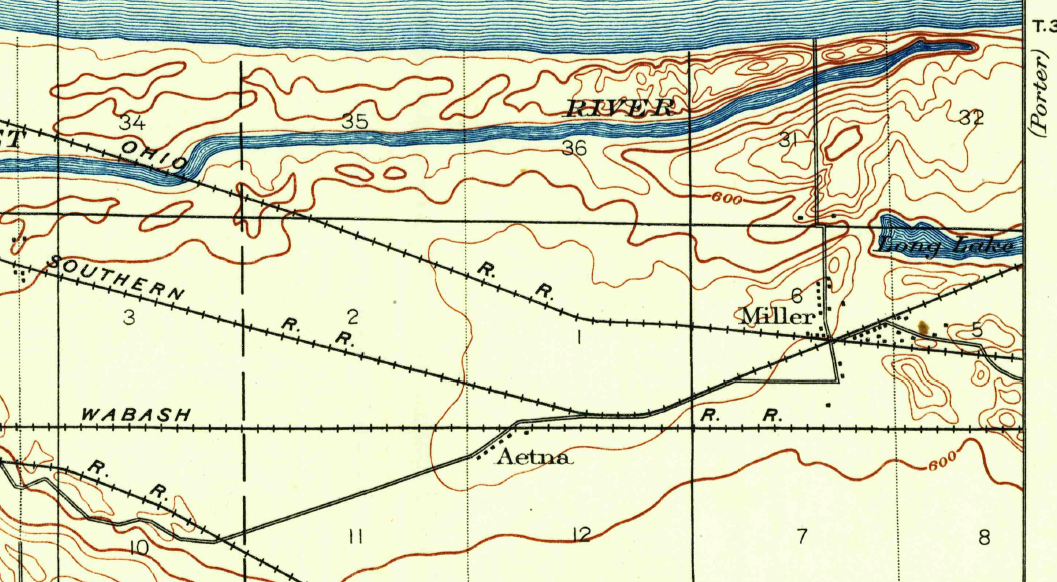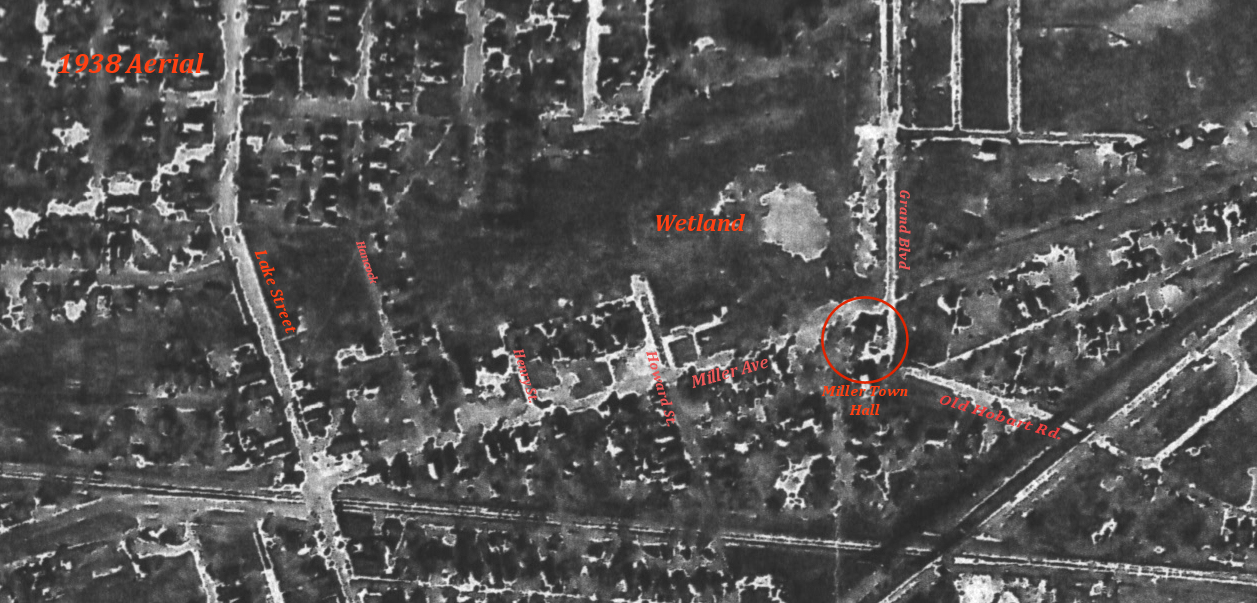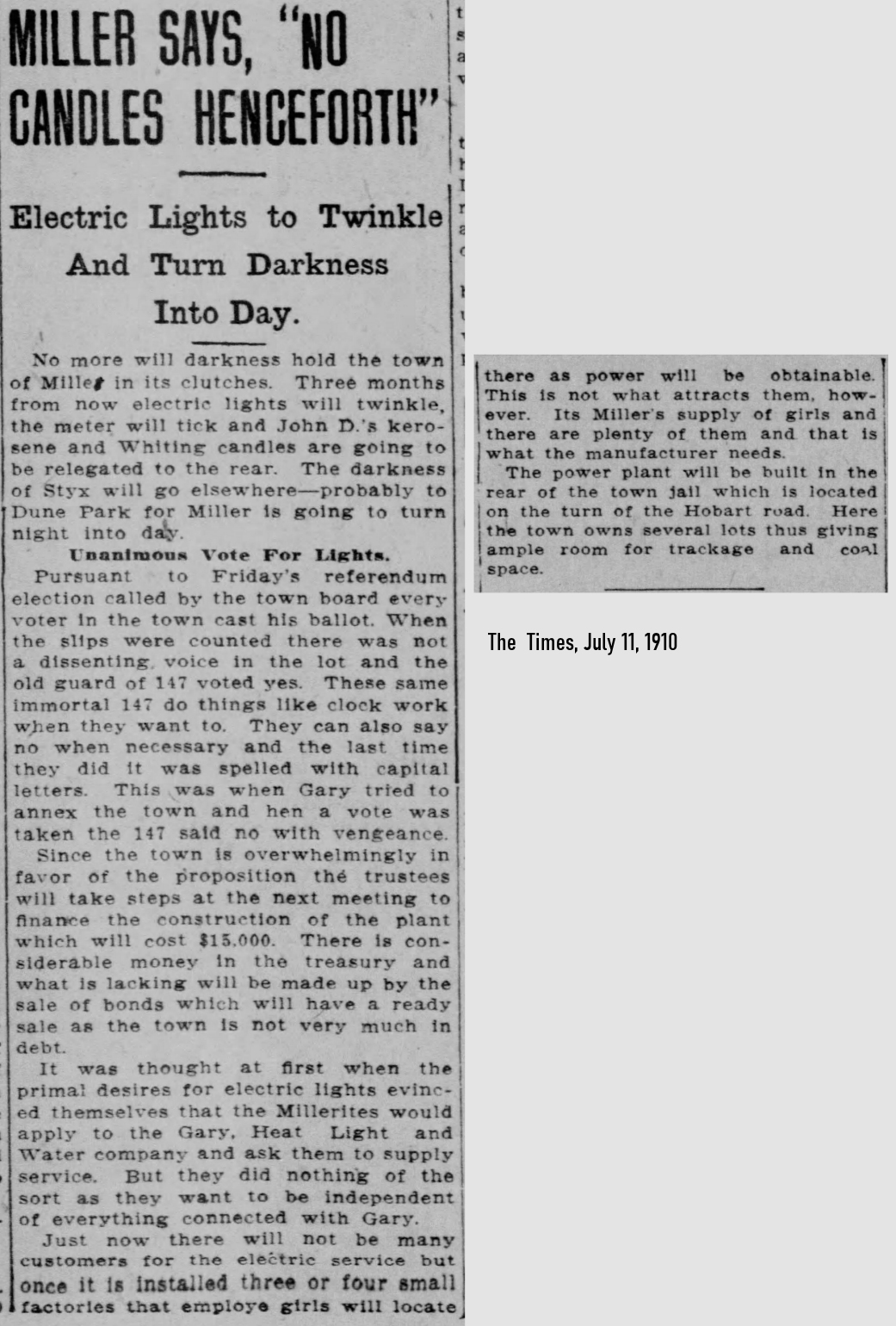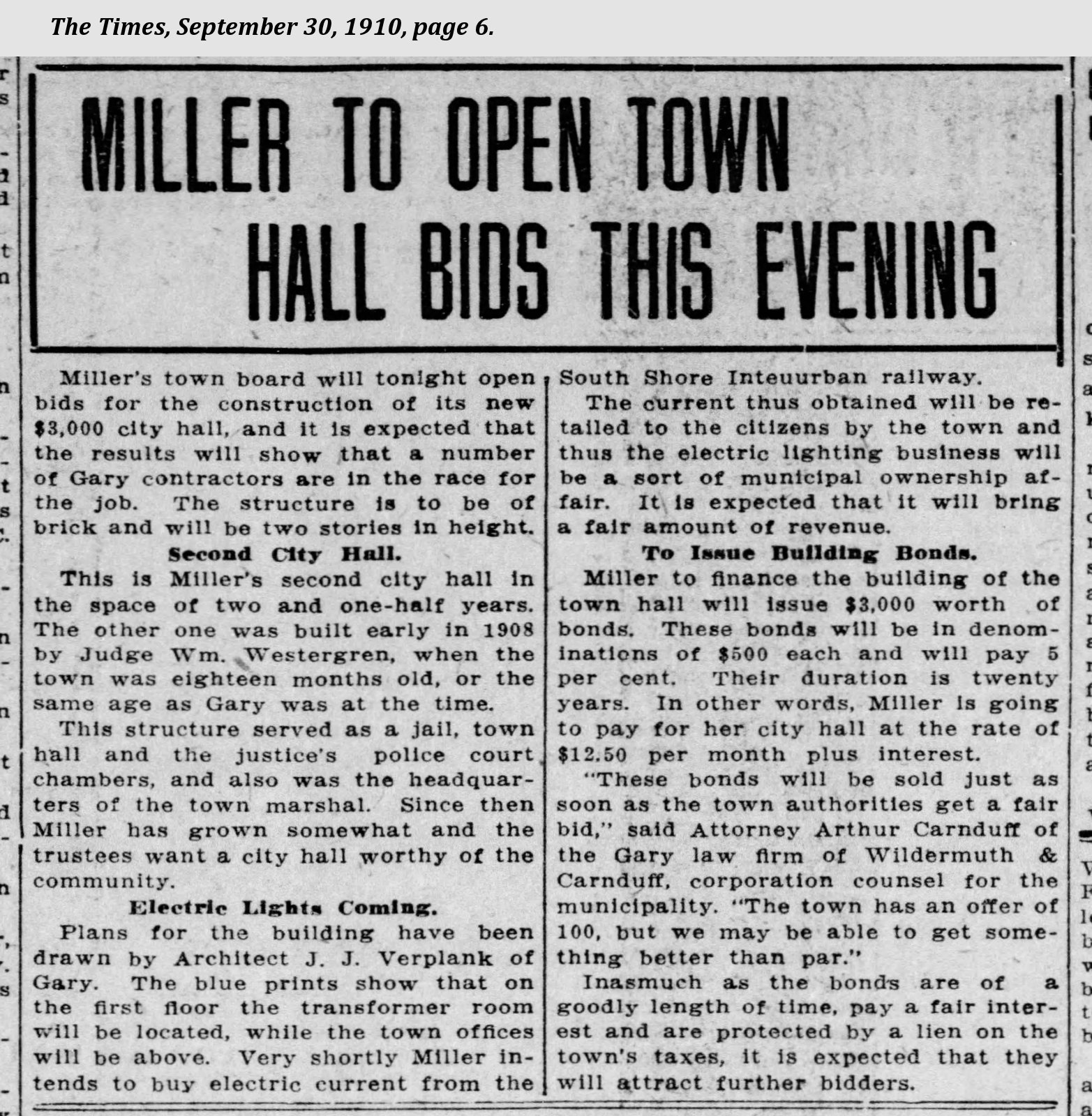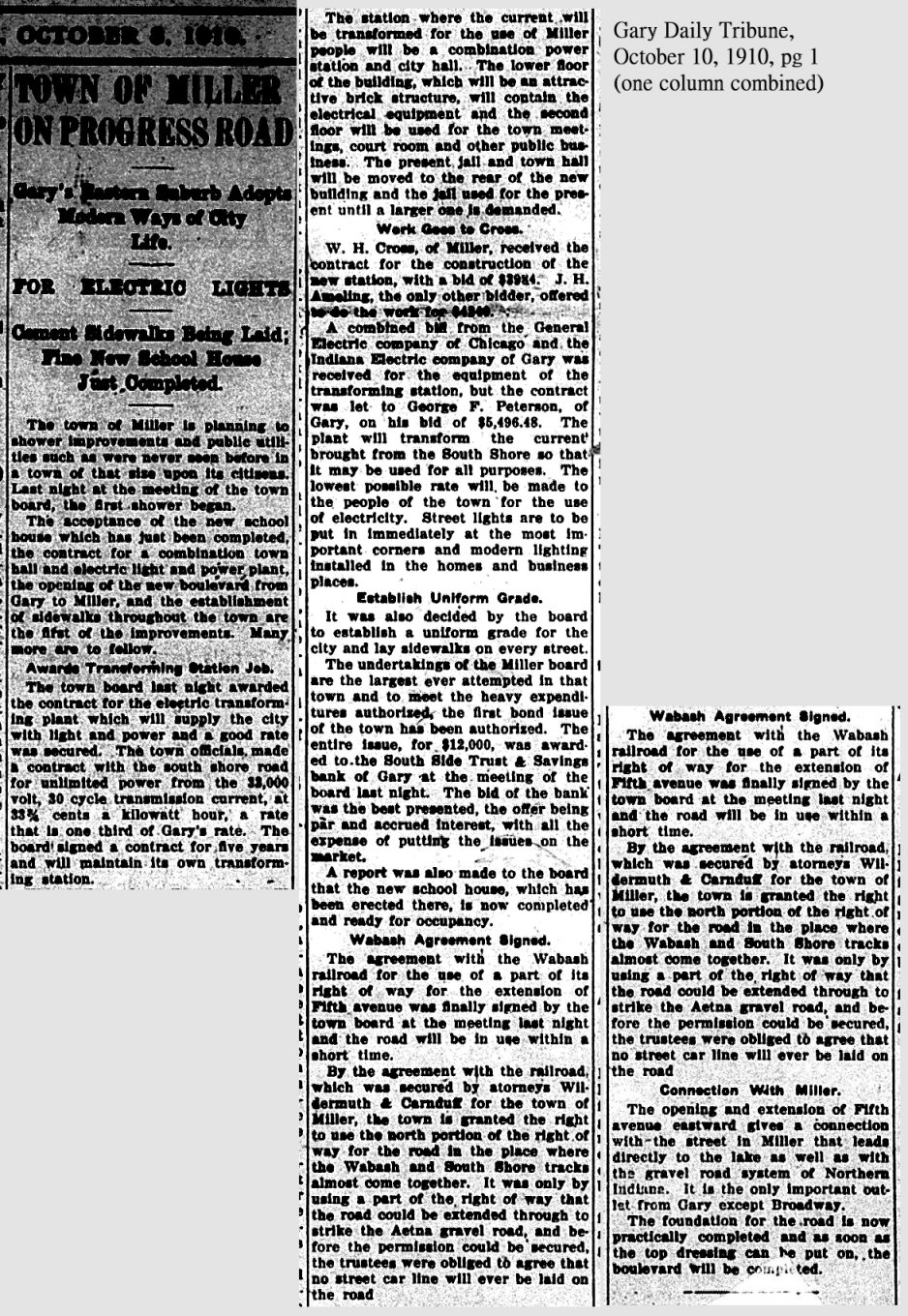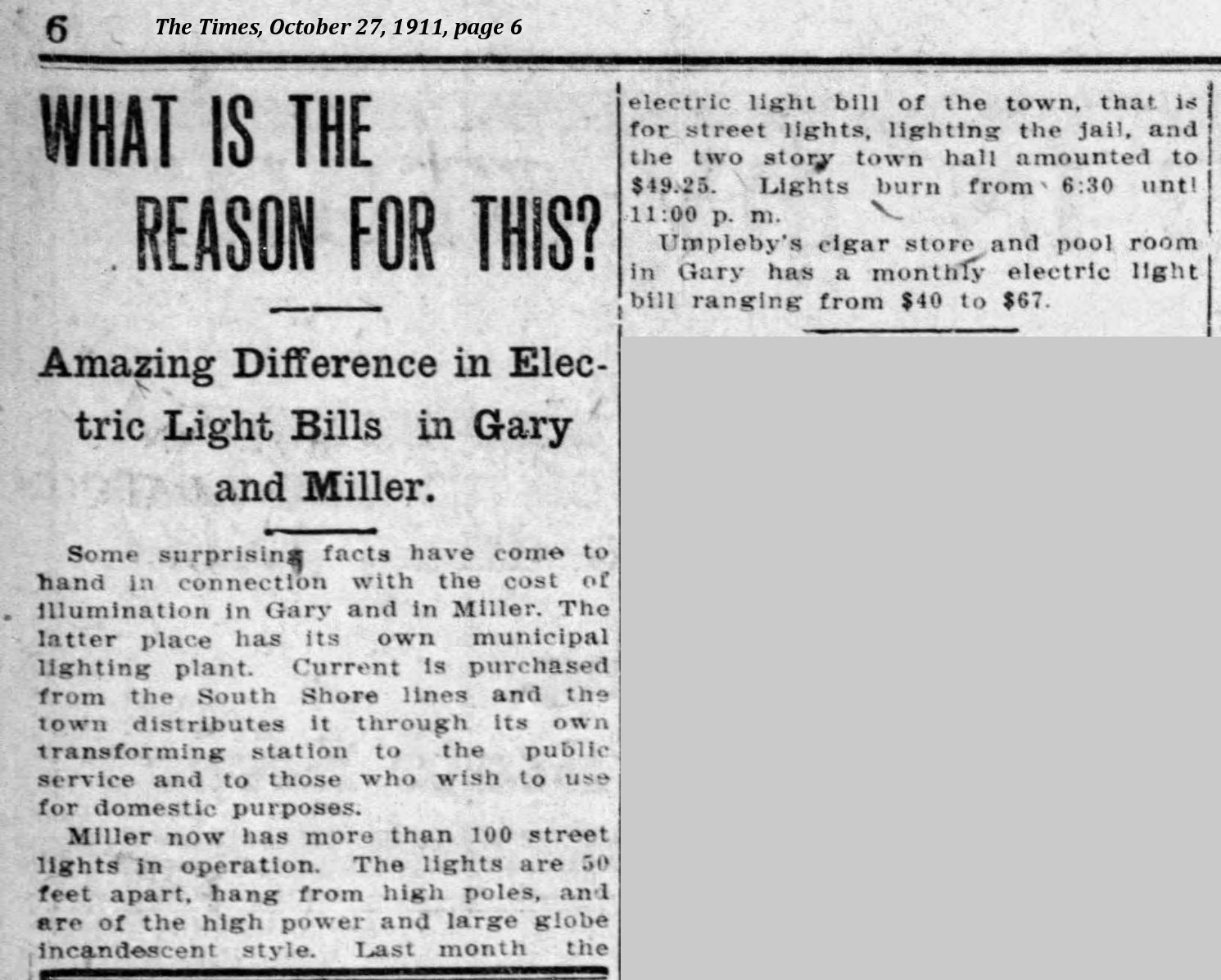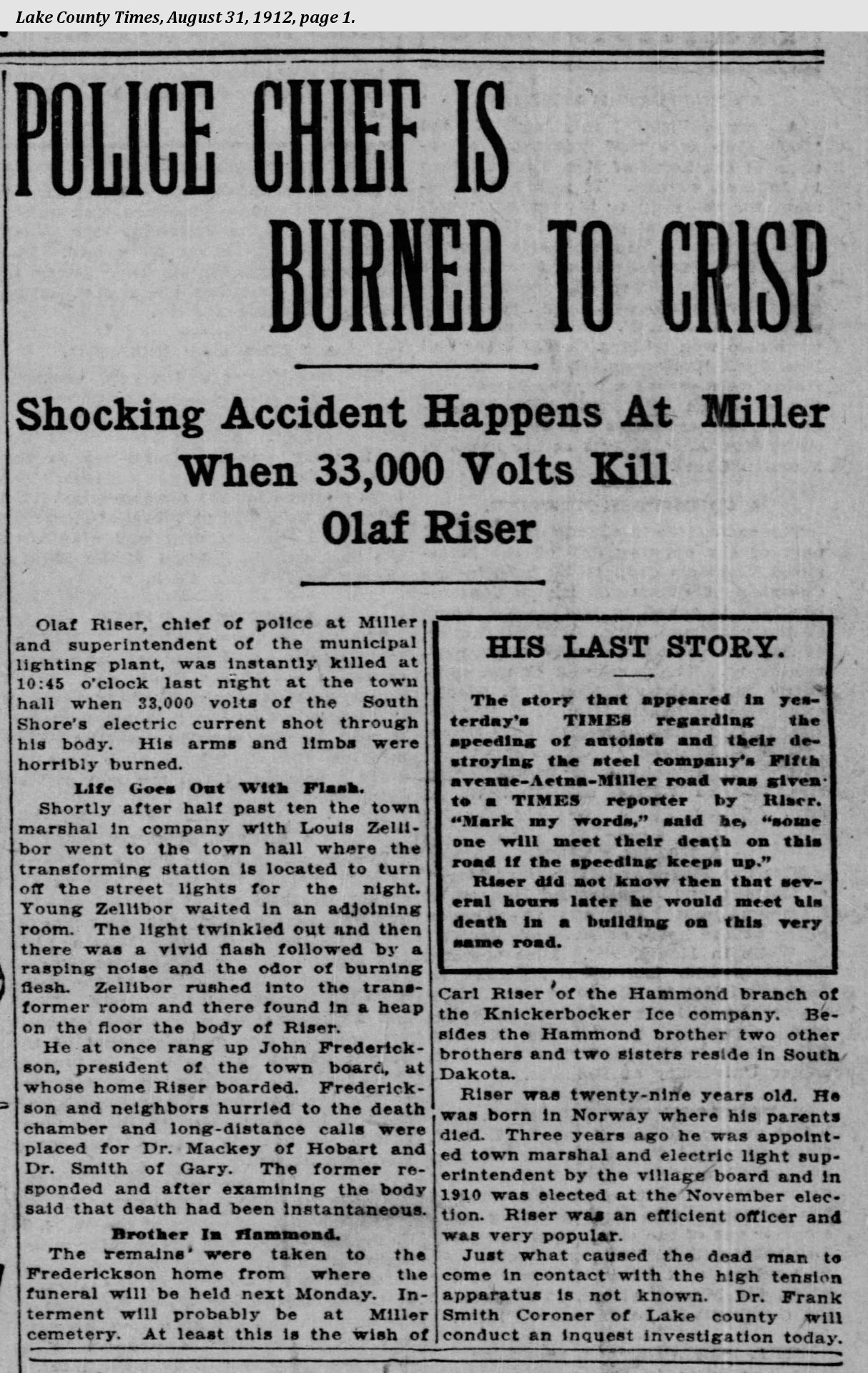Miller Town Hall
Draining Long Lake
Miller in 1910-1911
A history of the origins of the Miller Town Hall,
the draining of Long Lake, and the general climate of the town in these exciting two years in Miller history.
People today don't know that Long Lake, either side of County Line Road by the entrance to West Beach, once extended west all the way to Lake Street in Miller.
Draining it to claim acreage was a major operation occurring about the same time that the Town Hall was built.
Miller Town Hall is on the National Register of Historic Places.
I daresay that the majority of Gary and Miller residents don’t know what this building, at the intersection of Grand, Miller, and Hobart Road, is or was. Dating back to 1911, its origin is in the emergence of Miller as a ‘modern’ town – with street lights and all in the heady years of 1910 and 1911.

An editorial in the Lake County Times in October of 1910 was entitled “Miller’s Rising Star.” It began, “Old timers in Lake county must have gasped for breath Saturday last when they read in this newspaper of the revolutionary things that the Miller town board had done in the way of municipal improvements.” The charming editorial compared the folks of Cape Cod to the “descendants of Vikings” who inhabited Miller with its “quaint charm.”
The story began earlier. In July of 1910 there was a simple referendum vote: For an electric lighting plant or Against an electric lighting plant. The unanimous vote was “YES.” It is probably this more than anything that inspired the building of the Town Hall. The building at that location, built in early 1908 by Judge William Westergren who lived a block away, housed a jail, meeting room, court room and the town marshal’s office; not much room for an ‘electric lighting plant.’
Town officials didn’t hesitate. They reportedly planned to issue bonds worth $12,000 to build the power a power plant in a new town hall, erect 35 arc street lamps and sell electricity to Miller residents. The projected bond issue amount was likely a guess coming from one of the town trustees, or just reporters; one article says that amount, another says $25,000 in bonds. The final amount would be much less. Big doings were already going on in the little town. A sewer line was half finished, and system to drain Long Lake was underway. Once the new town hall was built attention would be to streets and sidewalks.(Footnote: 'MILLER TO OPEN TOWN HALL BIDS THIS EVENING,' The Times, 30 September 1910, page 6; 'TOWN OF MILLER ON PROGRESS ROAD,' Gary Daily Tribune, October 8, 1910, page 1. See Clippings Scrapbook below. )
Plans were drawn up by Gary architect J. J. Ver Plank. The blueprints showed a transformer room on the first floor with town offices on the second floor. Requests for bids went out and were opened September 30th. (Footnote: "MILLER TO OPEN TOWN HALL BIDS THIS EVENING," Lake County Times, 30 September 1910. See Clippings Scrapbook below. ) Contracts were awarded in the following weeks which included a contract with the South Shore Interurban Line to purchase, for five years, unlimited power at 33 ¾ cents a kilowatt hour, a rate that was one-third of Gary’s rate. A year later the Times would notice that rate differential. In an article titled “WHAT IS THE REASON FOR THIS?” there was shock expressed that the whole monthly bill for the town’s 100 street lights, the jail, and the Town Hall was $49.25 – about the same for a single pool room and cigar store in Gary.(Footnote: Monthly Electric Bill: Times, October 27, 1911, page 6. See Clippings Scrapbook below. ) Savvy Swedes in Miller evidently.
The Town Hall opened for business certainly by the end of April, 1911 when notices were in the paper for meetings of the new school board and the town council. Miller was gaining attention; on April 12th the Gary correspondent for the Indianapolis News filed a story about Miller’s advantage over Gary in having beachfront. The article exaggerated, claiming there were hundreds of summer homes along the beach and could turn into another Atlantic City, an exaggeration poo-pooed in the Gary Daily Tribune five days later in a condescending rebuttal that made light of Miller and its inhabitants. See the Appendix for more about this and a transcription of the Tribune article. While condescending and amusing, the article provides a visitor’s impression of what was going on in the town at the time, albeit mid-April.
October 16, 1911 meeting detailing progress, conflict, and proclaiming big plans. Click for full article.
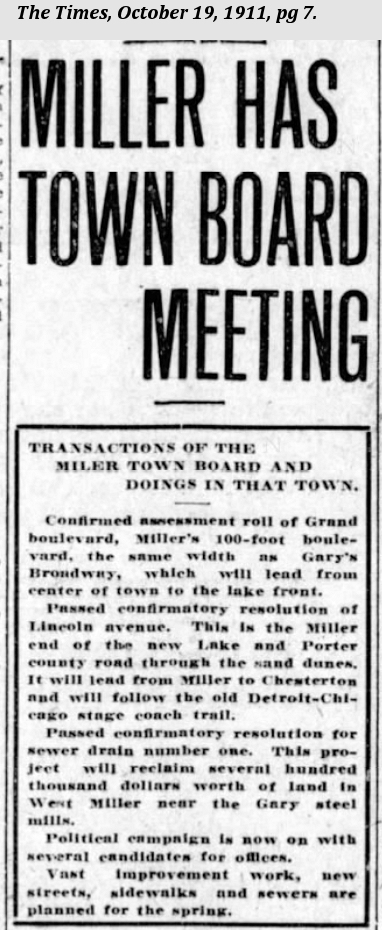
The Town Hall was a busy place immediately after opening and right up to Gary’s annexation of Miller. There were big plans, including more drainage, broadening Lake Street and extending it to the lake as a wide boulevard to be called Grand Boulevard. (Not to be confused with the current Grand Boulevard; folks had different ideas about a new name for Lake Street, including ‘Ocean Boulevard,’ but it remained Lake Street.)
Like the Saturday oyster supper and entertainment given by the volunteer fire department on March 2, 1912, (Footnote: Oyster Supper: Times, March 2, 1912, page 2 ) the Town Hall was no doubt a place for many such events. But its chief attraction to the newspapers were the often-contentious Town meetings that were held on the premises. Many were the discussions, and arguments, about the fate of the beachfront, coupled with discussions about roads, a nationwide topic in many communities now that the automobiles were out and about. William Gleason, the Gary Park board president, agreed in May of 1913 at a Town Hall meeting, to furnish cinders to improve Lake Street north from the Grand Calumet to the lake, expecting to erect a $5,000 bathhouse also that summer. (Footnote: Town Hall meeting on road and bathhouse:The Times, May 6, 1913, page 2. ) That continuing fight is discussed elsewhere on this website.
Within months, in late January of 1912, a volunteer fire department was organized at the Town Hall. Olaf Riser, the town marshal, became the fire brigade’s fire marshal as well. Riser would meet a tragic end in August when he was electrocuted by reported 33,000 volts of electricity which had been routed into the Town Hall from the South Shore Interurban to be transformed for the street lights and commercial sale; the Town Hall lies approximately 600 feet south of the South Shore down Old Hobart Road.
(Footnote:
33,000 volts: While this seems excessive, the South Shore ran on alternating current until 1926, likely close to that voltage and possibly 25Kv. Not verified, but if anyone has information on the South Shore’s electrification in its early years, please let me know.)
(Footnote:
Fire Department and Riser electrocution: “MILLER ORGANIZES FIRE DEPARTMENT,” The Times, Jan. 12, 1912, page 7;
“POLICE CHIEF IS BURNED TO CRISP,” The Lake County Times, August 31, 1912, page 1. See Clipping Scrapbook below.
)
The Gary City Council formally passed Ordinance 754 on February 17, 1919 making Miller Ward 10 of the City of Gary. See “From Bog to Park-the Annexation of Miller and the Building of Marquette Park” on this website for more on the fight for a park and the annexation fight. (New window or tab.)
Evidently, the Town Hall became the City of Gary’s Fire Station #7 almost immediately after annexation. When exactly that happened is unclear, but in the list of polling places in Lake County published in The Times on May 1, 1920, “Fire Station, Miller” was named as the polling place for Precinct 4 in Hobart Township.(Footnote:
Town Hall as Polling place: The Times, 1 May 1920, page 12
)
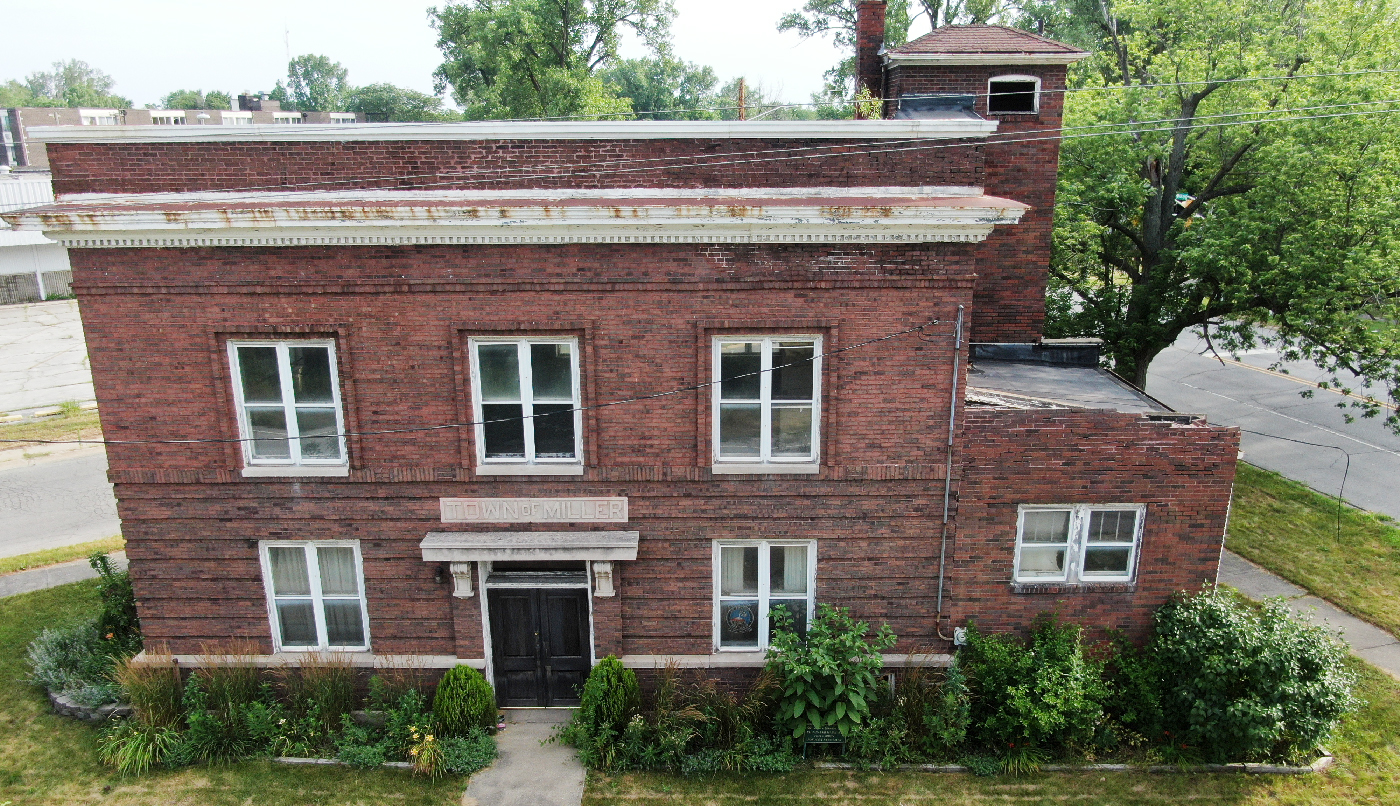 It remained Fire Station # 7 until 1975 when a new station was opened at 4th and Grand Boulevard two blocks north. Since that time the old Town Hall has seen off and on use as a community center, but without funds or maintenance is now included on the Indiana Landmarks list of endangered locations. (Footnote:
Miller Town Hall Faces Uncertain Future - posted October, 2019 by then Indiana Landmarks local coordinator. Other Indiana Endangered Places are at Endangered Places.
)
It remained Fire Station # 7 until 1975 when a new station was opened at 4th and Grand Boulevard two blocks north. Since that time the old Town Hall has seen off and on use as a community center, but without funds or maintenance is now included on the Indiana Landmarks list of endangered locations. (Footnote:
Miller Town Hall Faces Uncertain Future - posted October, 2019 by then Indiana Landmarks local coordinator. Other Indiana Endangered Places are at Endangered Places.
)
The National Register of Historic Places.
In 1976, Miller resident Richard Hagelberg nominated the Town Hall to the National Register of Historic Places. The nomination was accepted and the structure was placed on the Register in July of 1978. The 5-page version of the nomination contains a fairly comprehensive summary of its history which can be seen here in a new window.
The full 117 Mb, 14 page, record can be had in a new window or tab at The National Archives - includes maps and photographs. It's a big file so give it a few seconds. It can be downloaded as well.(Footnote: Town Hall reference number in the National Register is 78000038. National Archives identifier is 132003659. )
Indiana IHSSI County Survey No. 089-232-07085.
The Indiana State Historic Architectural and Archaeological Research Database (SHAARD) also has documentation on the site which is quite complete in its IHSSI County Survey database.
That can be reached by signing in as a Guest at https://secure.in.gov/apps/dnr/shaard/welcome.html, accept the terms, and then in the drop-down choose IHSSI (County Survey) and enter the Survey Number 089-232-07085 – from there choose “Action – View”.
Draining Long Lake
Folks today don’t realize that in the early days of Miller, Long Lake extended west almost all the way to Lake Street. Until the late 1950s the land at the corner of Miller Ave and Grand Blvd where the Wilco/Ralphs Grocery store used to be, and across from the Town Hall, was all wetland, cattails and all.(Footnote: Wilco opened for business in 1960. Wetland: conversations with Nora Thompson Myres, whose grandparents owned a house across Miller Avenue ((my house) in the 1950’s. Nora’s grandmother did not like the kids playing on the rusty old train gondola that had been used to bring in sand fill to raise the grade to its present level. The level wasn’t raised completely for the apartments north and caissons 60 feet deep had to be sunk for foundation according to Nora. ) While the claim by the Times article in September of 1910 that 700 acres of Long Lake was to be drained is no doubt an exaggeration, it is likely that in the neighborhood of two hundred acres or more were drained in 1909-10, some of the land reclaimed to build houses and streets.
Maps from the period are rather imprecise, and while often give conflicting impressions, at least four maps in the first decade of the 19th century show the extent of Long Lake into Miller. Below are two of those maps showing the approximate locations of Long Lake. I've included a current map for scale to show what 275 acres looks like and approximate to the water drained to the Little Calumet river.
F.L. Knight's 1906 Calumet Region of Lake County, Indiana: Prepared from the Official Records. Crown Point. Blueprint; Cadastral map showing landowners.
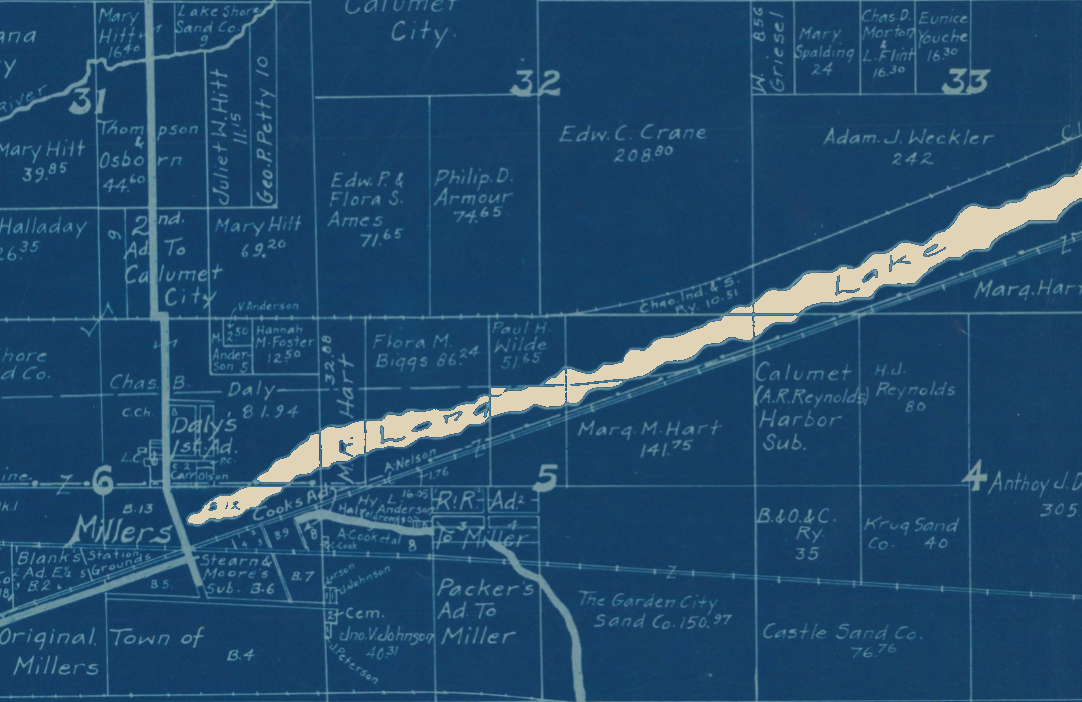
Edited to highlight Long Lake.
For the unedited version click here.
275 Acres
For scale only this map shows what 275 acres looks like on a current Google map.
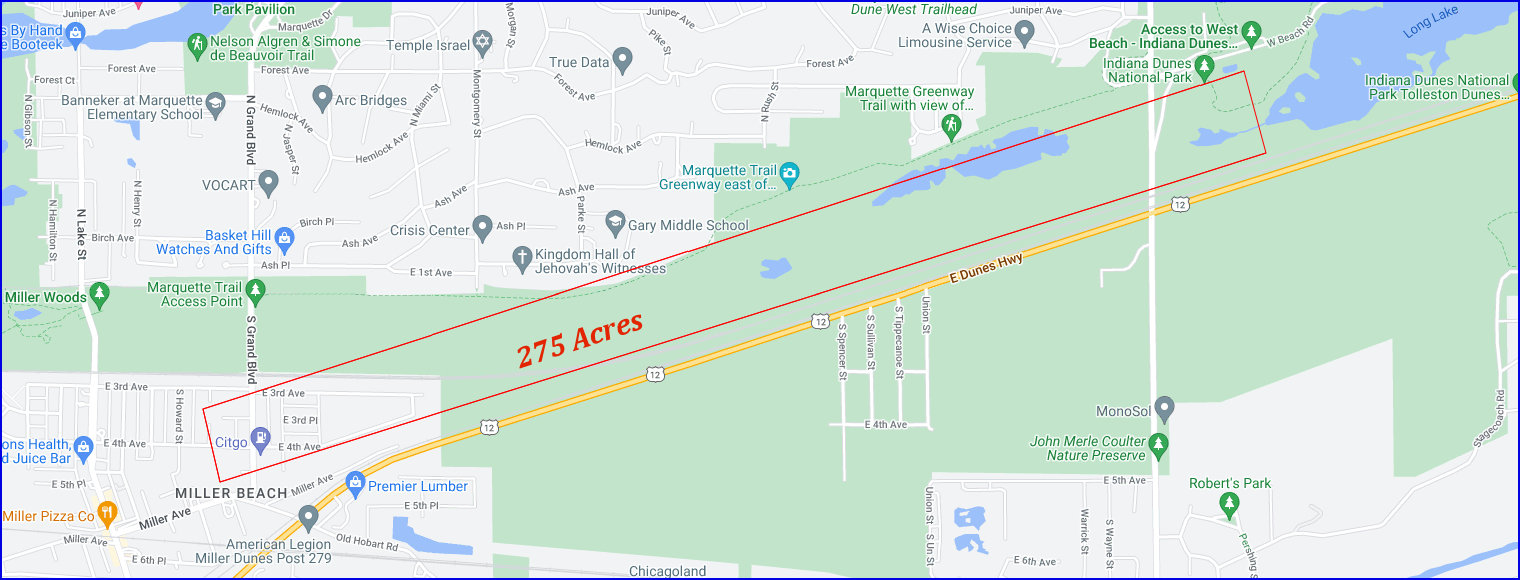
Approximate acreage. 275 acres shown for scale. (Footnote: 275 acres scale drawn using DaftLogic's Google Maps Area Calculator Tool. )
A 1938 Aerial showing Town Hall and where Wilco would be built.
Despite the existence of clouds, the black ridge-like bands in this 1938 aerial, it is obvious that this area was still very wet and originally part of Long Lake as mentioned above and in the footnote. The whiteish splotch to the right of “Wetland” is no doubt water, and where Wilco would be built. Thanks to Dorreen Carey for sharing this aerial that she acquired from the Purdue Extension and which I’ve scanned.
Appendix: Gary Daily Tribune condescending article on Miller.
In looking at the papers, the Lake County Times from Hammond, then the Lake County Times, and the Gary Daily Tribune from Gary, my impression right off is that Gary was condescending more often than not and the paper did not cover events in Miller as the more sympathetic Times was apt to do. Gary coveted Miller for its beachfront and looked down on the "dumb Swedes" in Miller. The following column was published in the Gary Daily Tribune following a little article in the Indianapolis News extolling Miller as the potential Atlantic City of the Midwest.
Transcription of "Miller Making of a Great Resort" - Gary Daily Tribune, April 11, 1911.
The Atlantic City of the Middle West, according to an item in the Indianapolis News is our neighboring town on the B. & O. railway and South Shore Electric line known as Miller. According to the Indianapolis report, Miller is the scene of boardwalks, million dollar piers and parasols in summer, and in winter the sound of the hammer rings out the story of preparation for a coming summer’s revelry.
The first thing you meet on entering the municipal boundaries of Miller is the new three-story school house erected last year. This school house replaced the one that was built about 1840 (sic), and which was somewhat out of repair by the close of the civil war. It was made to do service by the thrifty Milleries until last year however. In this lies the service by the thrifty Millerites until Nothing useless is stood for. Nothing that can be used is allowed to remain useless. The bricks from the old school house are now being used as a foundation for a new street to built to the city’s famous beach. Opinion is divided as to the name of this street. Some want to call it Ocean Park Boulevard. Others object to this on the grounds that, after all, Lake Michigan is not an ocean. One or two suggest Miller Avenue; but that does not sound very awe-inspiring somehow or other.
A Real Cement Walk
Passing the new school building, the pedestrian finds that the street immediately nort west of it has a real cement side-walk along one side. This street is a block long, ending in the C.L.S. & S.B. [South Shore] railroad embankment at one end and a swamp at the other.
Along the principal street, known as Lake Avenue, electric light poles are up. The wires, however, have not yet to be strung. The stringing of every pole, it is said, necessitates a special meeting of the town council.
Yesterday, which was rainy and rather uncomfortable, the only resemblance to a seaside resort that could be discovered in what might be termed the City Proper of Miller (an area on-eight of a mile square around the B. & O. depot), was a place called The Point, owned by a man named Arvidson. This was Old Point Comfort. Arvidson sells good beer.
The people of Miller are canny, and are not talkative with strangers. They have been building a sewer in Miller for something nigh on to two years. Two or three old residents were asked if it was finished yet. All replied that they didn’t know anything about it. Careful investigation gave the impression that it had been finished for three months at least. Possibly the three men asked lived just outside the eighth-mile square previously referred to around the depot and were not acquainted with city affairs.
Route for a Boulevard
The old Lake Shore right-of-way which was abandoned three years ago for the new right-of way north of the City Proper, is still in existence at Miller, and offers a fine opportunity for several miles of already graded boulevard. The Milleritest (sic) have not as yet, however, taken the matter up definitely.
They have a brand new jail in Miller. No one was in it yesterday. Breaking the law won’t raise crops.
The Irish in Miller speak English with a Swedish accent. The favorite newspaper is the Sevenska Kouriren printed in Chicago. One feels a distinctive Scandinavian atmosphere immediately on entering the City Proper, and the fact that “Nothin’ doin’” and “all right” are about the only real American expressions one hears, rather add to the impression that one is in some hamlet among the sweet smelling fir woods of Sweden than in the great city designated by the esteemed but always interesting News as the “Atlantic City of the Middle West.”
It is probably that the Millerites, who have heard of Atlantic City chiefly through the yellow journals and from hot references from the pulpit concerning the modern summer resorts (?irting), and other evils would consider a comparison between themselves and Atlantic City as a slur on their personal morality. And Miller it certainly is moral. There isn’t room to be anything else.
North of the City Proper of Miller, and some distance through hills of (?) and (?) of scrub oak, the Gary wayworn wandered, if he has the grit to keep going north on Lake Avenue long enough, will finally look upon the broad expanse of Lake Michigan through a rift in the sand mountains that gird her southern shore.
And before him will stetch the most magnificent beach the eye of man has ever seen. Here indeed is Miller’s one bid for greatness. Only a few little shacks and a couple of cottages for folks on hunting expeditions are visible along the mile after mile of shore; but what a shore! Smooth and white and broad, an ideal and glorious beach on which to play on a summer’s day and forget, for a while, in the brightness of the sky the azure of the lake and the broad sweep of sand, the thousand petty things that make life a task elsewhere.
You could take the City Proper of Miller and setting it down on the beach, stand away a bit and fancy it merely a rowboat half buried in the sand, as far as the size of it would compare with its surroundings.
But yesterday, not a soul was visible on the beach. Only, a few miles to the westward, the long line of stacks of the Indiana Steel Company rose against the sky and in the offing a steamer from Duluth trailed the horizon with smoke.
A return to the City Proper from the beach is an anti-climax. One gets the first car and returns to Gary. Miller has an Atlantic City beach, all right; but no one is building million dollar hotels along it – yet.
Clippings scrapbook
Sources for this history are primarily from the two newspapers, the Lake County Times and Gary Daily Tribune, and from the National Register Nomination form. While many of the newspaper clippings are in with the text, five mentioned in the footnotes are here. Click on the thumbnail to see the full article - use zoom and pan. (The Lake County Times was a predecessor to the Northwest Indiana Times of today.)
Footnotes:
Footnotes:
Page created August & September, 2022.
© Text copyright: Steve Spicer
Feel free to contact me about this page.
